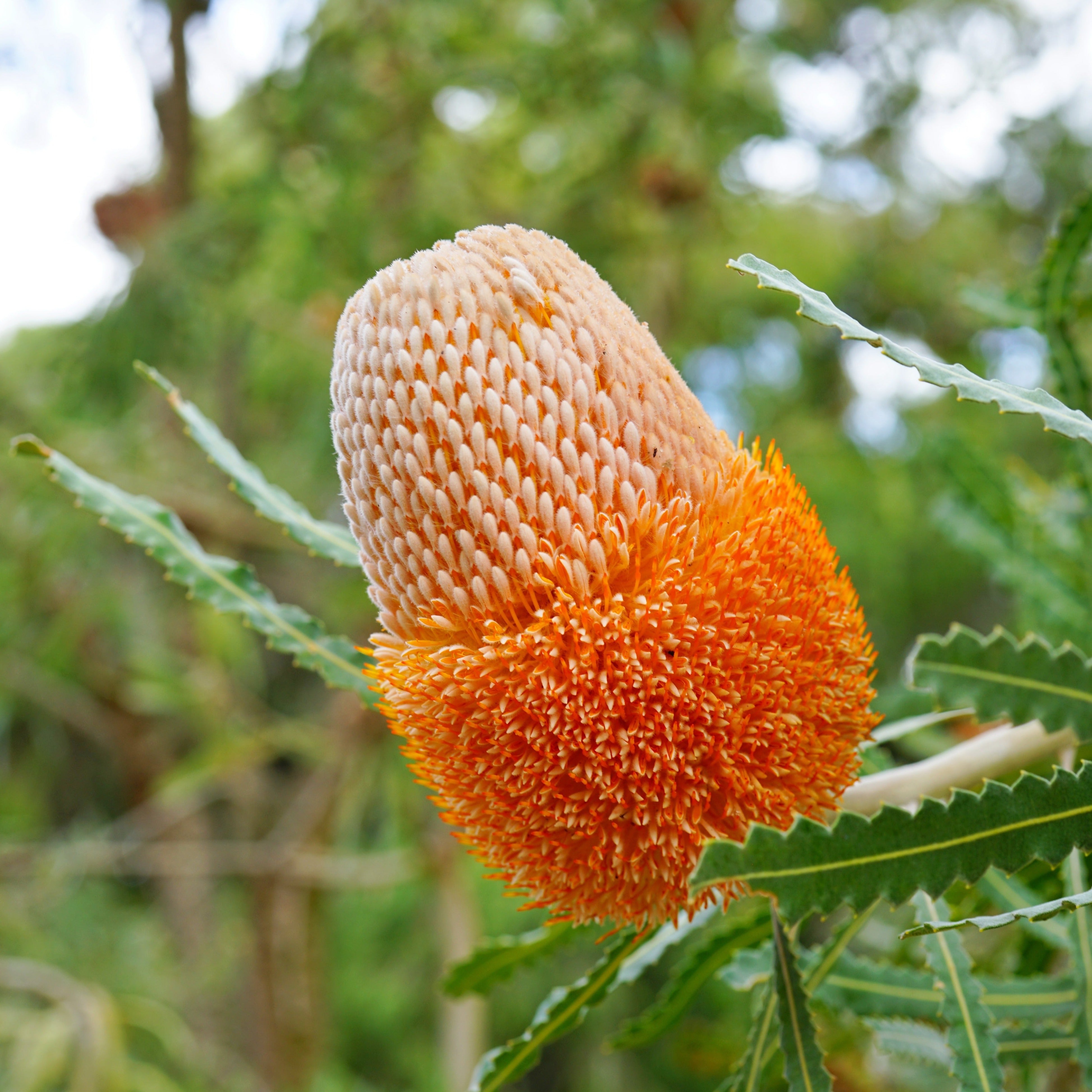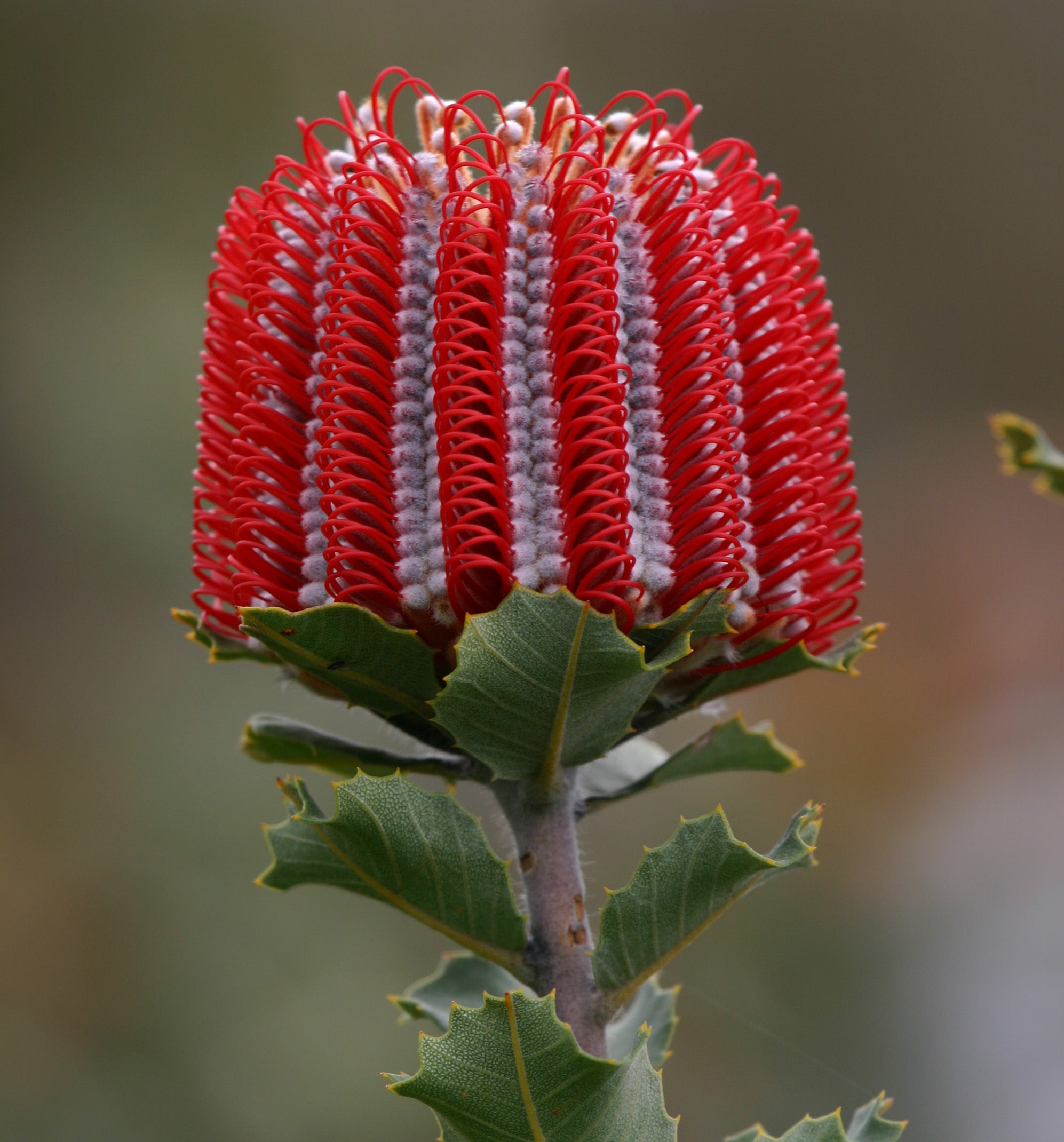Banksias are named after the botanist Sir Joseph Banks and are popular Australian natives due to their striking flower spikes made up of hundreds of smaller flowers. The nectar-rich flowers are great for attracting bees and birds to your garden, and they also make excellent cut flowers for indoor arrangements, releasing a sweet honey fragrance.
Banksias also produce unique, woody seed pods, which may remind you of the “big bad Banksia men” if you’ve read the children’s book Snugglepot & Cuddlepie by May Gibbs.
There are over 170 species of banksias, with all but one being native to Australia. They range from ground covers to tall trees, and their flowers come in shades of yellow, orange, pink, and red, with many species sporting beautifully serrated leaves. Commonly grown species in home gardens include Banksia spinulosa, Banksia speciosa, and Banksia ericifolia, while cultivars like ‘Giant Candles’ and ‘Birthday Candles’ are also popular for their prolific blooming.
Table of Contents
ToggleHow to Grow Banksias
Choose a sunny location with well-draining soil to prevent root rot. They thrive in sandy soils but will appreciate some added organic matter. If you have clay soil, improve it with gypsum and consider raising the garden bed to help with drainage. Apply OCP eco-seaweed in the first few weeks to help the banksia settle into its new environment.

Banksias don’t have a deep taproot, and it can take up to two years for them to fully establish. Keep an eye on them during their first two summers, providing extra water during hot spells. Once established, they become quite drought-tolerant.
To grow banksias from seed, you’re in luck because the seeds are highly viable and germinate easily within a few days. However, extracting the seeds from the cones can be tricky! The seeds are housed deep inside the cone, and the capsules only open after exposure to high temperatures, such as during bushfires. To replicate this, place the cone in an oven at 100-150°C for 1-2 hours until the capsules open, releasing the seeds. Be careful not to let the cone catch fire!
Sow the seeds directly into a garden bed or a well-draining native potting mix. Water them in with OCP eco-seaweed, and soon you’ll have baby banksias growing.

Fertilising Banksias
Banksias have specialized proteoid roots, which help them grow in Australia’s nutrient-poor soils. They don’t require much fertiliser and are especially sensitive to high phosphorus levels, particularly when young. Apply a certified organic fertiliser safe for natives, or one with a phosphorus content of less than 2%, once or twice a year.
If you want to encourage young plants to grow faster, apply a mixture of OCP eco-seaweed and OCP eco-aminogro every 2-4 weeks, which are safe for all native plants.

Pruning Banksias
Banksias generally require minimal pruning. Trim any dead branches and prune back to control size or shape if necessary. You can cut off the finished flower spikes if you prefer, but they also make striking features if left to age naturally on the plant.

Pest & Disease Problems of Banksias
Banksias are easy to grow but can encounter a few issues:
- Caterpillars: Several caterpillar species feed on banksias. On larger, established plants, they may cause minimal damage and can be left alone. However, species like the Grevillea looper can cause significant damage, especially on young plants. In such cases, use OCP eco-neem to control them.
- Scale: These small sap-sucking insects usually appear on stems and can be controlled with organic insecticides. If left untreated, scale infestations can lead to the development of sooty mold.
- Root Rot: Poor drainage can lead to root rot diseases like Phytophthora, which is particularly problematic for Western Australian species. Affected plants will show brown leaves that cling to branches while drooping, and the plant usually dies quickly. Improve soil drainage and add organic matter, such as compost, to restore beneficial soil microbes.
- Phosphorus Toxicity: Yellowing new leaves and brown edges on older leaves can indicate phosphorus toxicity. Since banksias are sensitive to phosphorus, excessive application can cause toxicity symptoms, sometimes taking up to 12 months to appear. To revive affected plants, apply weekly doses of OCP eco-seaweed and OCP eco-aminogro to boost the plant’s health. Adding an iron supplement can also help bind excess phosphorus in the soil.
